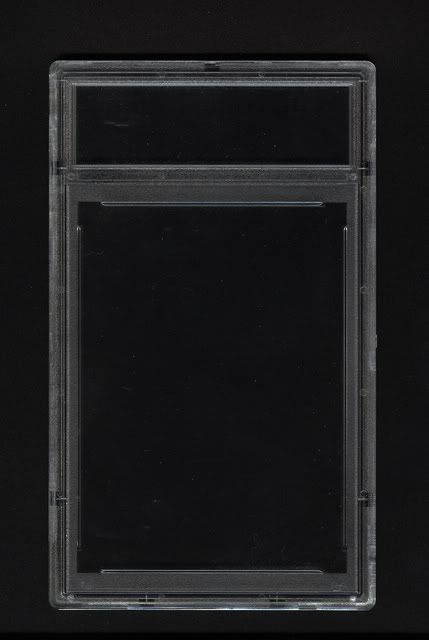One additional thought regarding graded cards. It is very important to maintain a healthy level of skepticism whenever buying cards, even those that have been graded, and "slabbed" by reputable companies like Professional Sports Authenticator (PSA), Beckett, and Sportscard Guarantee (SGC).
Never assume that a card is authentic because somebody else tells you it is. There are people out there that try to make money off of unsuspecting collectors, using these graded card cases to further their scams.
This is what PSA's slab looks like without a card, or a "flip" (the printed portion at the very top of the slab which includes the name of the player, the year and company that has produced the card, the card number, and the grade.)

Placed against a black background, you can see what the plastic slab looks like. Upon inspection, you want to be on the lookout for abnormally "white" portions of the slab, which can be indicative of the slab "being popped". This is referred to as frosting. While a little bit of light frosting is common in the production of these slabs, more pronounced frosting is often the first sign that a slab has been tampered with. And when I mean tampered with, I mean opened to remove the original card, and replace it with a lesser quality card, or a fake. Though the slabs vary from one company to another, common practice is to "sonically weld" the top and bottom pieces together, forming a strong seam. These seams can be exploited, however. There are videos on Youtube you can look up to show how this is done. Basically, an x-acto blade, and a screwdriver head, weaken the seam, and pry it open. Besides the bright white frosting that is evident, you also want to test the strength of the slab itself. Holding the top portion of the slab (near the flip), and the lower portion, try to gently bend the slab. If there is any give, you want to immediately examine the card itself. Even if there is not any give, you still want to examine the flip along the seam, looking for signs that it's been cracked, and re-glued. Look for micro-fractures.
Keep in mind, too, that occasionally, the TPG (third-party graders) change their flips. They might alter how the information is layed out, or add additional information to the flip. If you are unsure about a flip, search the internet to find examples of old flips. Or, ask somebody on the forum to take a look at it.
Scammers try to steal from buyers with these graded cards in a few ways. One approach is to crack open a legitimately-graded card, so they can remove the card, and replace it with a card of lower quality. Say, for instance, the scammer has a 1957 Topps Mickey Mantle that PSA has graded an 8. They would pop this, and replace it with a 6, and sell it as the 8. The card would command the higher price an 8 would fetch on the open market. This is where the examination of the slab, the flip, and the card itself are important. Another approach scammers use is to replace the legitimate cards with reproductions, either reprints, or forgeries. Reprints will often have the word "reprint" included on the back of the card somewhere (but not always), and the cards will often exhibit some minor difference from the original. Be on the look out for alterations to the card backs where the word "reprint" would normally be found. In this example, a legitimate slab + flip are used to sell a card that is not authentic. Lastly, the other option crooks have is to use slabs and flips that have been created for the purpose of stealing from the consumer. These do not come from the legitimate TPGs. They are produced in other countries. The flips, too, will be faked. This is where a loupe is helpful. Examine the typography utilized on the flip, and compare it to an authentic example.
The mantra of "buy the card, not the holder" should ring in your head whenever you buy a graded card. If you are buying a card in person, examine the card itself, the slab and the flip. If you are buying a card online that has been graded, look over the pictures provided...carefully. Does the card entombed in plastic match the grade on the flip? Does the slab exhibit any examples of tampering? Does the flip, and any hologram used, look right? And as always, does the seller pass the sniff test?
I don't want new hobbyists to be frightened by the information I am sharing. This is a great hobby, and the vast majority of people who collect are in it for the right reason. You just need to always be on the defensive. You need to be proactive. Even if you are buying a valuable card from a trusted seller, still go through these steps. Because while the TPGs go to lengths to insure the safety of the public, card graders are human, and can make mistakes. Never assume that your seller's card is authentic. Sellers can be duped, too. They can buy cards they think are legitimate, and a careful scam artist might be able to fool even the most seasoned seller if they are doing considerable volume.
Establish good habits, and they will serve you well. When you buy cards online, know what kinds of protection your payment method(s) offer. Don't assume, ask! And be aware of what price the card you are looking to buy has been commanding. You can use VCP (vintagecardprices.com), or even look at EBay history for an idea. If somebody is selling a card that usually goes for $1,000 for $400 buy it now, something is amiss. The old mantra of "if it's too good to be true, it probably is" applies to our hobby, too.